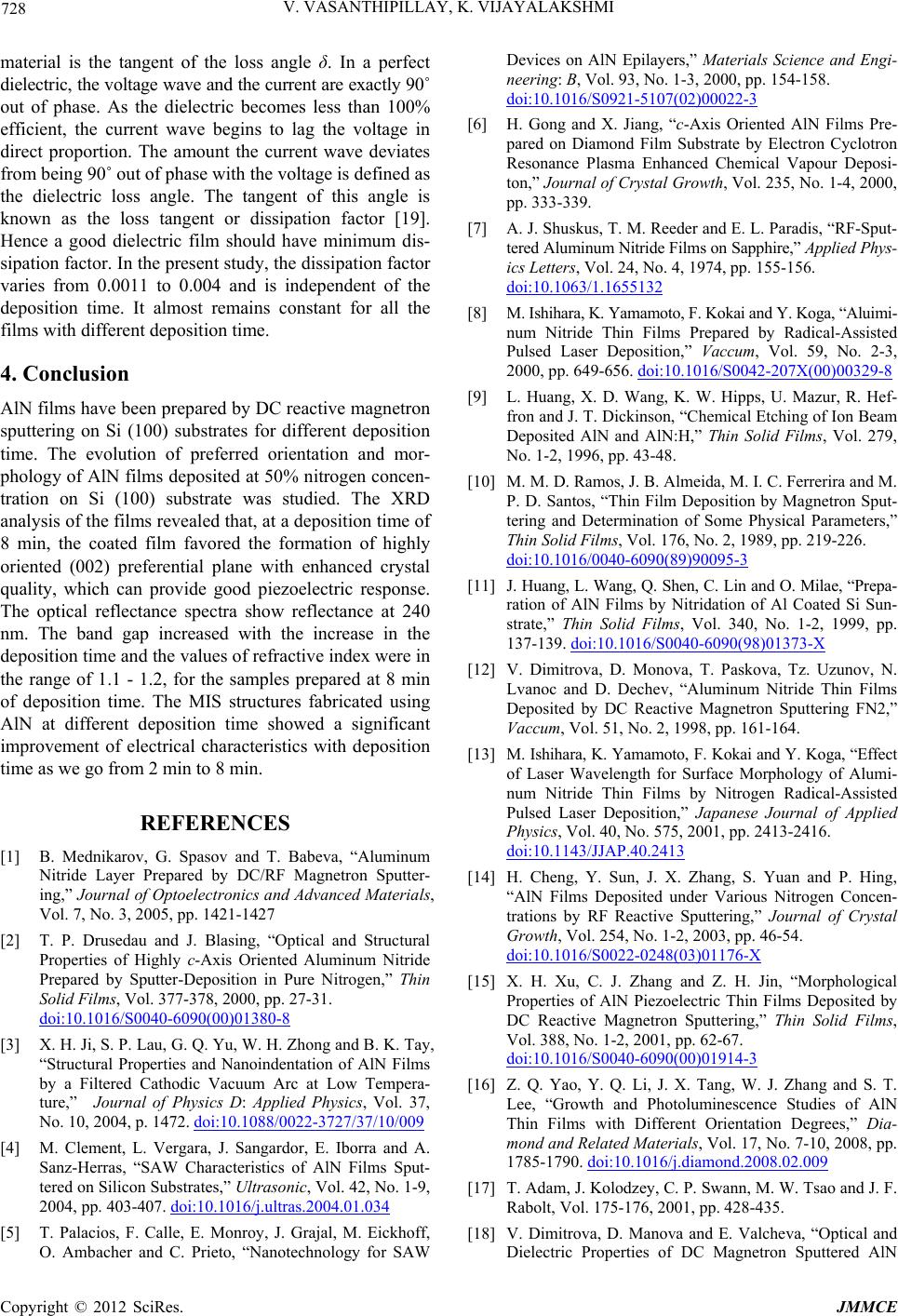
V. VASANTHIPILLAY, K. VIJAYALAKSHMI
728
material is the tangent of the loss angle δ. In a perfect
dielectric, the voltage wave and the current are exactly 90˚
out of phase. As the dielectric becomes less than 100%
efficient, the current wave begins to lag the voltage in
direct proportion. The amount the current wave deviates
from being 90˚ out of phase with the voltage is defined as
the dielectric loss angle. The tangent of this angle is
known as the loss tangent or dissipation factor [19].
Hence a good dielectric film should have minimum dis-
sipation factor. In the present study, the dissipation factor
varies from 0.0011 to 0.004 and is independent of the
deposition time. It almost remains constant for all the
films with different deposition time.
4. Conclusion
AlN films have been prepared by DC reactive magnetron
sputtering on Si (100) substrates for different deposition
time. The evolution of preferred orientation and mor-
phology of AlN films deposited at 50% nitrogen concen-
tration on Si (100) substrate was studied. The XRD
analysis of the films revealed that, at a deposition time of
8 min, the coated film favored the formation of highly
oriented (002) preferential plane with enhanced crystal
quality, which can provide good piezoelectric response.
The optical reflectance spectra show reflectance at 240
nm. The band gap increased with the increase in the
deposition time and the values of refractive index were in
the range of 1.1 - 1.2, for the samples prepared at 8 min
of deposition time. The MIS structures fabricated using
AlN at different deposition time showed a significant
improvement of electrical characteristics with deposition
time as we go from 2 min to 8 min.
REFERENCES
[1] B. Mednikarov, G. Spasov and T. Babeva, “Aluminum
Nitride Layer Prepared by DC/RF Magnetron Sputter-
ing,” Journal of Optoelectronics and Advanced Materials,
Vol. 7, No. 3, 2005, pp. 1421-1427
[2] T. P. Drusedau and J. Blasing, “Optical and Structural
Properties of Highly c-Axis Oriented Aluminum Nitride
Prepared by Sputter-Deposition in Pure Nitrogen,” Thin
Solid Films, Vol. 377-378, 2000, pp. 27-31.
doi:10.1016/S0040-6090(00)01380-8
[3] X. H. Ji, S. P. Lau, G. Q. Yu, W. H. Zhong and B. K. Tay,
“Structural Properties and Nanoindentation of AlN Films
by a Filtered Cathodic Vacuum Arc at Low Tempera-
ture,” Journal of Physics D: Applied Physics, Vol. 37,
No. 10, 2004, p. 1472. doi:10.1088/0022-3727/37/10/009
[4] M. Clement, L. Vergara, J. Sangardor, E. Iborra and A.
Sanz-Herras, “SAW Characteristics of AlN Films Sput-
tered on Silicon Substrates,” Ultrasonic, Vol. 42, No. 1-9,
2004, pp. 403-407. doi:10.1016/j.ultras.2004.01.034
[5] T. Palacios, F. Calle, E. Monroy, J. Grajal, M. Eickhoff,
O. Ambacher and C. Prieto, “Nanotechnology for SAW
Devices on AlN Epilayers,” Materials Science and Engi-
neering: B, Vol. 93, No. 1-3, 2000, pp. 154-158.
doi:10.1016/S0921-5107(02)00022-3
[6] H. Gong and X. Jiang, “c-Axis Oriented AlN Films Pre-
pared on Diamond Film Substrate by Electron Cyclotron
Resonance Plasma Enhanced Chemical Vapour Deposi-
ton,” Journal of Crystal Growth, Vol. 235, No. 1-4, 2000,
pp. 333-339.
[7] A. J. Shuskus, T. M. Reeder and E. L. Paradis, “RF-Sput-
tered Aluminum Nitride Films on Sapphire,” Applied Phys-
ics Letters, Vol. 24, No. 4, 1974, pp. 155-156.
doi:10.1063/1.1655132
[8] M. Ishihara, K. Yamamoto, F. Kokai and Y. Koga, “Aluimi-
num Nitride Thin Films Prepared by Radical-Assisted
Pulsed Laser Deposition,” Vaccum, Vol. 59, No. 2-3,
2000, pp. 649-656. doi:10.1016/S0042-207X(00)00329-8
[9] L. Huang, X. D. Wang, K. W. Hipps, U. Mazur, R. Hef-
fron and J. T. Dickinson, “Chemical Etching of Ion Beam
Deposited AlN and AlN:H,” Thin Solid Films, Vol. 279,
No. 1-2, 1996, pp. 43-48.
[10] M. M. D. Ramos, J. B. Almeida, M. I. C. Ferrerira and M.
P. D. Santos, “Thin Film Deposition by Magnetron Sput-
tering and Determination of Some Physical Parameters,”
Thin Solid Films, Vol. 176, No. 2, 1989, pp. 219-226.
doi:10.1016/0040-6090(89)90095-3
[11] J. Huang, L. Wang, Q. Shen, C. Lin and O. Milae, “Prepa-
ration of AlN Films by Nitridation of Al Coated Si Sun-
strate,” Thin Solid Films, Vol. 340, No. 1-2, 1999, pp.
137-139. doi:10.1016/S0040-6090(98)01373-X
[12] V. Dimitrova, D. Monova, T. Paskova, Tz. Uzunov, N.
Lvanoc and D. Dechev, “Aluminum Nitride Thin Films
Deposited by DC Reactive Magnetron Sputtering FN2,”
Vaccum, Vol. 51, No. 2, 1998, pp. 161-164.
[13] M. Ishihara, K. Yamamoto, F. Kokai and Y. Koga, “Effect
of Laser Wavelength for Surface Morphology of Alumi-
num Nitride Thin Films by Nitrogen Radical-Assisted
Pulsed Laser Deposition,” Japanese Journal of Applied
Physics, Vol. 40, No. 575, 2001, pp. 2413-2416.
doi:10.1143/JJAP.40.2413
[14] H. Cheng, Y. Sun, J. X. Zhang, S. Yuan and P. Hing,
“AlN Films Deposited under Various Nitrogen Concen-
trations by RF Reactive Sputtering,” Journal of Crystal
Growth, Vol. 254, No. 1-2, 2003, pp. 46-54.
doi:10.1016/S0022-0248(03)01176-X
[15] X. H. Xu, C. J. Zhang and Z. H. Jin, “Morphological
Properties of AlN Piezoelectric Thin Films Deposited by
DC Reactive Magnetron Sputtering,” Thin Solid Films,
Vol. 388, No. 1-2, 2001, pp. 62-67.
doi:10.1016/S0040-6090(00)01914-3
[16] Z. Q. Yao, Y. Q. Li, J. X. Tang, W. J. Zhang and S. T.
Lee, “Growth and Photoluminescence Studies of AlN
Thin Films with Different Orientation Degrees,” Dia-
mond and Related Materials, Vol. 17, No. 7-10, 2008, pp.
1785-1790. doi:10.1016/j.diamond.2008.02.009
[17] T. Adam, J. Kolodzey, C. P. Swann, M. W. Tsao and J. F.
Rabolt, Vol. 175-176, 2001, pp. 428-435.
[18] V. Dimitrova, D. Manova and E. Valcheva, “Optical and
Dielectric Properties of DC Magnetron Sputtered AlN
Copyright © 2012 SciRes. JMMCE